The Nikon SB-700 is a mid-range Speedlight flash, offering versatility and power for photographers. Announced in 2010, it features a guide number of 28 (ISO 100, 35mm FX) and wireless capabilities, making it ideal for professionals and enthusiasts seeking enhanced lighting control.
1.1 Overview of the Nikon SB-700 Speedlight
The Nikon SB-700 Speedlight is a versatile and powerful flash unit designed for photographers seeking professional lighting control. Announced in 2010, it serves as a mid-range option, replacing the SB-600. With a guide number of 28 (ISO 100, 35mm FX), it offers wireless capabilities, multiple flash modes, and compatibility with Nikon DSLR and mirrorless cameras. Its compact design and user-friendly interface make it ideal for both professional photographers and hobbyists looking to enhance their lighting techniques.
1.2 Key Features and Capabilities
The Nikon SB-700 Speedlight features a guide number of 28 at ISO 100 and 35mm, providing sufficient power for various lighting applications. It supports multiple flash modes, including i-TTL, Manual, and Repeating Flash, offering flexibility in different shooting scenarios. Wireless capabilities allow for off-camera flash control, enhancing creativity. Additionally, it is compatible with Nikon DSLR and mirrorless cameras, making it a versatile tool for photographers. The flash also includes a built-in wide-angle panel and bounce card for soft, diffused lighting effects.
1.3 Importance of the SB-700 in Photography
The Nikon SB-700 Speedlight is a crucial tool for enhancing image quality in various lighting conditions. Its versatility and reliability make it ideal for both amateur and professional photographers. The flash provides precise control over lighting, enabling the creation of dynamic and balanced compositions. Its portability and ease of use allow photographers to achieve professional results in both indoor and outdoor settings, making it an essential accessory for capturing stunning images with depth and dimension.
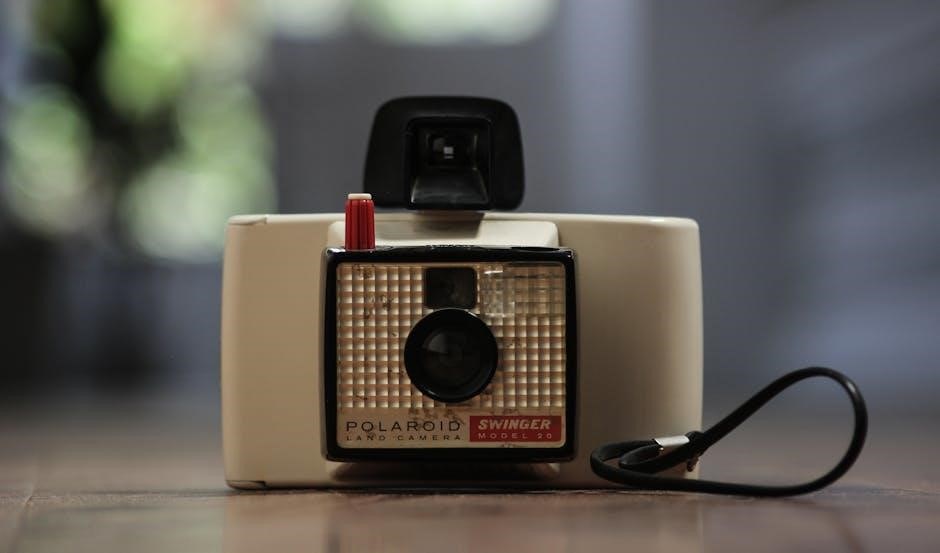
Key Features and Specifications
The Nikon SB-700 offers a guide number of 38m/125ft at ISO 100, covering a wide 24-120mm zoom range. It supports FX and DX formats, wireless operation, and multiple flash modes, ensuring versatility for diverse lighting needs.
2.1 Guide Number and Coverage
The Nikon SB-700 features a guide number of 38m/125ft at ISO 100, providing powerful illumination for various shooting scenarios. It covers a wide-angle zoom range of 24-120mm, automatically adjusting to match the camera’s sensor size (FX or DX format). The flash head also supports 14mm coverage with the built-in wide-angle panel, ensuring even lighting across the frame. This versatility makes it suitable for both portraits and wide-angle photography, delivering consistent results in diverse lighting conditions.
2.2 Compatible Camera Models
The Nikon SB-700 is compatible with a wide range of Nikon DSLR and mirrorless cameras, including the D850, D500, D7500, Z6, Z7, and Z50. It works seamlessly with cameras featuring Nikon’s i-TTL flash control system. The flash is also backward compatible with older Nikon models, ensuring versatility for photographers using various camera bodies. This broad compatibility makes the SB-700 a versatile choice for both professional and enthusiast photographers across different Nikon systems.
2.3 Wireless Flash Capabilities
The Nikon SB-700 supports advanced wireless flash photography, enabling off-camera lighting setups. It operates as both a master and remote flash, allowing control of up to three groups across four wireless channels. With a reliable range of up to 30 feet, it ensures consistent communication between units. This feature enhances creativity by enabling multi-flash setups for dynamic lighting effects, making it ideal for studio and location photography. Wireless operation requires AA batteries for power.

Unboxing and Accessories
The SB-700 comes with the flash unit, a stand, and a diffusion dome. Additional accessories include filters, a soft case, and an adapter for enhanced functionality.
3.1 What’s Included in the Box
The Nikon SB-700 box includes the flash unit, a bounce card, diffusion dome, soft case, and stand. A user manual and warranty information are also provided. These items ensure photographers have everything needed to begin using the flash effectively, whether for on-camera or off-camera setups. Additional accessories, like filters, can be purchased separately to enhance functionality and customization.
3.2 Optional Accessories for Enhanced Functionality
Optional accessories for the Nikon SB-700 include colored gels for creative effects, the SD-8 Battery Pack for faster recycling, and remote triggers for wireless operation. Additional diffusers, softboxes, and umbrellas can enhance light control. These accessories expand the flash’s versatility, offering photographers more creative and technical options for various lighting scenarios. They are designed to integrate seamlessly with the SB-700, ensuring optimal performance and compatibility.
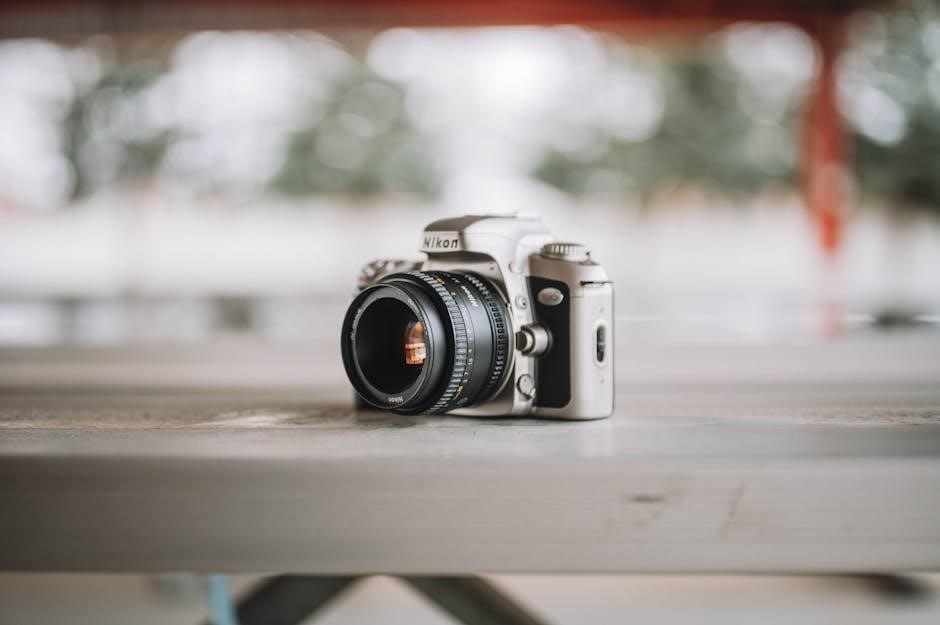
Setting Up the Nikon SB-700
Mounting the flash, installing batteries, and configuring basic settings are straightforward. Adjusting exposure compensation, wireless settings, and custom functions ensures optimal performance. Easy to integrate with Nikon cameras.
4.1 Mounting the Flash on the Camera
Mouting the Nikon SB-700 on your camera is straightforward. Align the flash’s hot shoe with the camera’s hot shoe mount, ensuring it clicks securely into place. Turn the camera off before attaching to prevent damage. Once mounted, lock the flash using the mounting foot. Check that the connection is firm and the flash is recognized by the camera, indicated by the flash-ready light on the camera’s control panel. This ensures a quick and secure setup for photography sessions.
4.2 Installing Batteries
To power the Nikon SB-700, insert four AA alkaline or NiMH batteries into the battery compartment located on the bottom of the flash unit. Open the compartment by sliding it downward, then align the batteries according to the polarity markings. Close the compartment securely. Turn the flash on to ensure proper operation. For optimal performance, use high-quality, fully charged batteries. Rechargeable NiMH batteries are recommended for cost and environmental benefits. Avoid mixing old and new batteries to maintain consistent power delivery.
4.3 Basic Settings and Configuration
After installing the batteries, turn on the SB-700 by sliding the power switch. Select the desired flash mode using the mode button. Adjust settings like flash compensation, sync modes, and wireless options via the camera’s menu or the flash’s LCD panel. Ensure the flash is set to the correct channel for wireless use. Save your configurations for quick access during shoots. Proper setup ensures consistent and reliable performance, allowing you to focus on capturing the perfect shot with precise control over lighting.
Understanding Flash Modes
The Nikon SB-700 offers multiple flash modes, including i-TTL, Manual, and Repeating modes, each designed for different lighting scenarios and creative control over flash output.
5.1 i-TTL Mode for Automatic Flash Control
The i-TTL mode on the Nikon SB-700 leverages the camera’s advanced metering system for precise flash exposure. It automatically adjusts flash output based on the scene, ensuring balanced lighting and natural results. This mode is ideal for beginners and professionals alike, offering quick and reliable performance in various shooting conditions. It minimizes manual adjustments, allowing photographers to focus on composition and creativity while maintaining optimal illumination.
5.2 Manual Mode for Custom Flash Output
The Manual Mode on the Nikon SB-700 allows photographers to set the flash power manually, giving full control over the output. This mode is ideal for experienced shooters who want precise lighting. The flash power can be adjusted from 1/1 to 1/128 in 1/3 EV increments. It’s perfect for creative control in studio or controlled lighting setups, enabling photographers to customize the flash output to achieve the desired effect in their images.
5.3 Repeating Flash Mode for Creative Effects
The Repeating Flash Mode on the Nikon SB-700 enables the flash to fire multiple times during a single exposure, creating unique stroboscopic effects. This mode is ideal for capturing motion sequences or adding dynamic elements to images. Photographers can adjust the number of flashes and frequency to achieve desired visual results, making it a versatile tool for creative and experimental photography projects.
Custom Functions and Settings
Custom functions on the Nikon SB-700 allow photographers to tailor flash behavior to their preferences, enhancing creativity and workflow efficiency in various shooting scenarios.

6;1 Accessing and Configuring Custom Functions
To access custom functions on the Nikon SB-700, press and hold the MENU button until the custom function menu appears on the LCD. Use the up and down buttons to navigate through the options. Select a function using the center button and adjust settings with the left and right buttons. Save your changes by pressing the MENU button again to exit. This allows you to customize flash behavior according to your needs.
6.2 Adjusting Flash Compensation
To adjust flash compensation on the Nikon SB-700, press the camera’s D-pad up or down to access the Flash Compensation menu. Use the left or right buttons to increase or decrease the compensation in 1/3 EV increments. This feature allows you to fine-tune the flash output for more balanced exposures, especially in challenging lighting conditions. The changes are displayed on the camera’s LCD screen for easy verification.
6.3 Setting Up Flash Sync Modes
Setting up flash sync modes on the Nikon SB-700 allows you to control how the flash fires in relation to the camera’s shutter. The default mode is Front-Curtain Sync, which fires the flash at the start of the exposure. For creative effects, switch to Rear-Curtain Sync, where the flash fires just before the shutter closes. Slow Sync combines flash with a slower shutter speed for balanced lighting. Access these modes via the camera’s Custom Setting Menu under Bracketing/Flash.
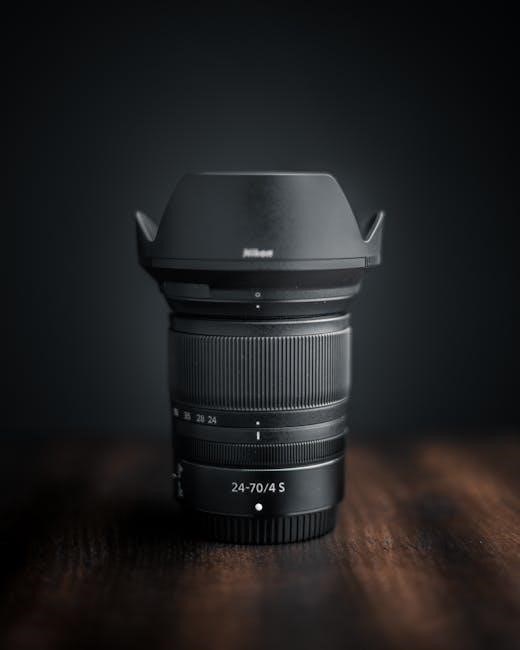
Wireless Flash Photography
Wireless flash photography with the Nikon SB-700 offers flexibility and creative control. This section explores how to use the flash in wireless modes for enhanced lighting effects.
7.1 Master and Remote Modes Explained
The Nikon SB-700 can operate in Master or Remote modes for wireless flash photography. Master mode allows the SB-700 to control other remote flashes, enabling synchronized lighting setups. Remote mode lets the flash function as a slave, triggered by a master flash or the camera’s built-in flash. This flexibility enhances creative control, allowing photographers to achieve complex lighting effects effortlessly. Understanding these modes is essential for maximizing wireless flash capabilities in various shooting scenarios.
7.2 Setting Up Wireless Channels
Setting up wireless channels on the Nikon SB-700 ensures reliable communication between master and remote flashes. Choose a channel (1-4) on both the master and remote units to synchronize them. This prevents interference from other wireless devices. Ensure all units are set to the same channel for consistent triggering. The SB-700’s intuitive interface makes channel selection straightforward, allowing photographers to focus on capturing images without connectivity issues.
7.3 Tips for Effective Wireless Flash Use
For optimal wireless flash performance, position the SB-700 to avoid direct line-of-sight obstructions. Use diffusers or softboxes to soften harsh light. Test flash range limits in different environments. Organize multiple units into separate channels to minimize interference. Experiment with flash angles for dynamic effects. Ensure firmware is updated for compatibility. Regularly clean wireless sensors to maintain reliable communication. This ensures consistent and professional results in various lighting scenarios.
Maintenance and Care
Regularly clean the flash head and electrical contacts. Store the SB-700 in a protective case. Avoid exposure to extreme temperatures and moisture. Replace batteries promptly to prevent corrosion.
8.1 Cleaning the Flash Unit
Use a soft, dry cloth to gently wipe the flash head, reflector, and exterior surfaces. Avoid harsh chemicals or alcohol, as they may damage the unit. For stubborn smudges, lightly dampen the cloth with distilled water. Never submerge the flash in liquid or expose it to excessive moisture. Regular cleaning prevents dust buildup and ensures optimal performance. Clean the battery compartment with a dry cloth to avoid corrosion. Always store the flash in a dry, cool environment after cleaning.
8.2 Storing the SB-700 Properly
Store the Nikon SB-700 in a cool, dry place away from direct sunlight. Use the original case or a protective cover to shield it from dust and physical damage. Avoid extreme temperatures or humidity. Remove batteries when storing for extended periods to prevent corrosion. Keep the flash unit detached from the camera to maintain both devices’ functionality. Proper storage ensures the SB-700 remains in optimal condition for future use.
8.3 Updating Firmware
Regularly update the Nikon SB-700’s firmware to ensure optimal performance and compatibility. Visit Nikon’s official website to check for the latest firmware version. Download the update to your computer, then transfer it to the flash unit using a compatible USB cable. Follow on-screen instructions carefully to avoid interruptions. Updating firmware enhances functionality, fixes bugs, and maintains compatibility with newer camera models. Always use a fully charged battery or connect via USB during the process.
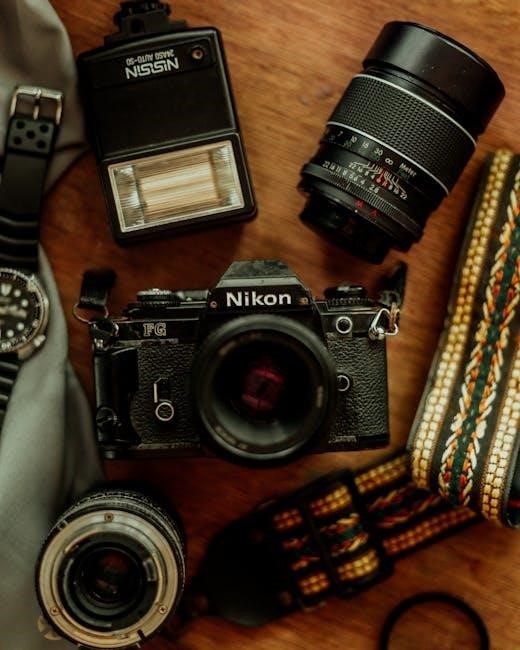
Troubleshooting Common Issues
Troubleshoot issues like uneven flash output or miscommunication by checking connections, ensuring fresh batteries, and resetting the flash. Consult the manual or Nikon support for guidance.
9.1 Resolving Battery and Power Issues

Check battery levels and ensure they are installed correctly. Use fresh alkaline or nickel-based rechargeable batteries for optimal performance. Clean the battery contacts with a soft cloth to remove dirt or corrosion. If issues persist, try replacing batteries or resetting the flash unit. Always refer to the Nikon SB-700 manual for specific guidelines on resolving power-related problems effectively.
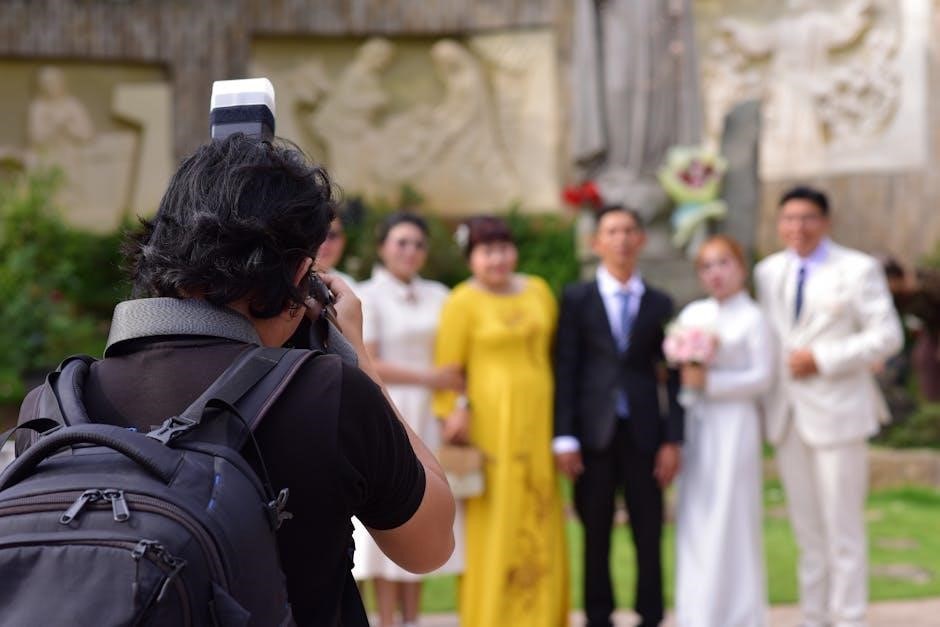
9.2 Fixing Communication Problems with the Camera
To resolve communication issues, ensure the flash is properly mounted on the camera’s hot shoe. Clean the flash foot and camera contacts with a soft cloth. Verify that both devices are set to compatible modes. Check wireless channels if using remote flash. Reset the flash by disabling and re-enabling wireless mode. Update the firmware to the latest version from the Nikon website for optimal compatibility and performance.
9.3 Addressing Overheating Concerns
If the Nikon SB-700 overheats, turn it off and allow it to cool down. Avoid continuous use in high-power modes or rapid bursts. Reduce flash output or use lower power settings. Ensure good airflow around the unit and avoid direct sunlight exposure. Check for firmware updates, as they may improve thermal management. Using an external power source, like Nikon’s SD-8A Battery Pack, can also help reduce heat buildup during extended use.
Advanced Techniques with the SB-700
Explore advanced techniques like multi-flash setups, creative lighting, and high-speed sync for dynamic results. Master studio, portrait, and event photography with precision and control using the SB-700.
10.1 Using the SB-700 for Studio Photography
The Nikon SB-700 excels in studio photography, offering precise control over lighting. Use manual mode for custom flash output and wireless functionality for multi-flash setups. Its compatibility with Nikon’s Creative Lighting System allows seamless integration with other units. High-speed sync and consistent output ensure professional results. Experiment with creative lighting patterns and ratios to enhance your studio workflow and achieve dynamic, studio-quality images with ease and precision;
10.2 Creating Dynamic Portraits with Off-Camera Flash
The SB-700 shines in off-camera setups, enabling creative control for dynamic portraits. Position the flash to add depth and dimension, eliminating flat lighting. Use wireless mode to trigger the flash from your camera, ensuring seamless operation. Adjust flash compensation and power levels to achieve natural or dramatic effects. Experiment with angles and distances to create subtle highlights or deep shadows, enhancing your subject’s features for striking, professional-quality portraits every time.
10.3 Enhancing Event Photography with the SB-700
The SB-700 elevates event photography with its portability and wireless capabilities, ensuring dynamic lighting in diverse settings. Its quick recycling time and long battery life keep up with fast-paced events. Use the flash to add depth and dimension to photos, balancing ambient and flash light seamlessly. The SB-700’s intuitive controls allow quick adjustments, making it ideal for capturing spontaneous moments with professional-grade lighting, no matter the event’s size or complexity.

Compatibility with Nikon Cameras and Accessories
The SB-700 is designed to seamlessly integrate with Nikon DSLR and mirrorless cameras, offering compatibility with a wide range of lenses and accessories for enhanced versatility.
11.1 Compatible Nikon DSLR and Mirrorless Models
The Nikon SB-700 is compatible with a wide range of DSLR and mirrorless cameras, including the D5, D850, D750, Z6, Z7, and Z50 models. It also works seamlessly with Nikon’s latest firmware updates, ensuring optimal performance across various camera bodies. This broad compatibility makes the SB-700 a versatile tool for photographers using different Nikon systems, offering consistent flash results and advanced features like i-TTL and wireless capabilities.
11.2 Using the SB-700 with Nikon Lenses
The SB-700 flash is designed to work seamlessly with Nikon lenses, including DX and FX formats. It supports focal lengths from 24mm to 120mm, ensuring wide coverage for various photography needs. The flash automatically adjusts its output based on the lens’s maximum aperture, providing accurate illumination. Regular firmware updates ensure compatibility with the latest Nikon lenses, maintaining optimal performance for both stills and video applications.
11.3 Integrating the SB-700 with Nikon’s Creative Lighting System
The SB-700 seamlessly integrates with Nikon’s Creative Lighting System (CLS), enabling advanced wireless flash control. It supports both master and remote modes, allowing photographers to create complex lighting setups. The flash communicates wirelessly with compatible cameras and other CLS-enabled units, offering precise control over multiple flashes. This integration enhances creativity and professionalism, enabling dynamic lighting arrangements for a wide range of photography scenarios.
The Nikon SB-700 is a reliable and versatile flash unit, offering advanced features for professional and enthusiast photographers. Its ease of use, wireless capabilities, and compatibility make it an essential tool for achieving stunning results in various lighting conditions.
12.1 Summary of the Nikon SB-700’s Capabilities
The Nikon SB-700 offers a powerful guide number of 38.1m (at ISO 100, 35mm), wireless flash control, and i-TTL automation. It supports multiple flash modes, including manual, repeating, and wireless options. With compatibility across Nikon cameras and lenses, it integrates seamlessly into Nikon’s Creative Lighting System. Its intuitive design and robust performance make it a versatile tool for photographers seeking professional-grade lighting solutions.
12.2 Final Tips for Maximizing the Flash’s Potential
To maximize the Nikon SB-700’s potential, experiment with bounce and swivel techniques for softer, more natural light. Adjust flash compensation to balance ambient and flash illumination. Practice wireless setups for creative off-camera lighting. Regularly update firmware and maintain proper battery care. Explore diffusers and modifiers for unique effects. Familiarize yourself with custom functions for tailored settings. Lastly, experiment with different flash modes to unlock its full creative versatility for stunning results.
